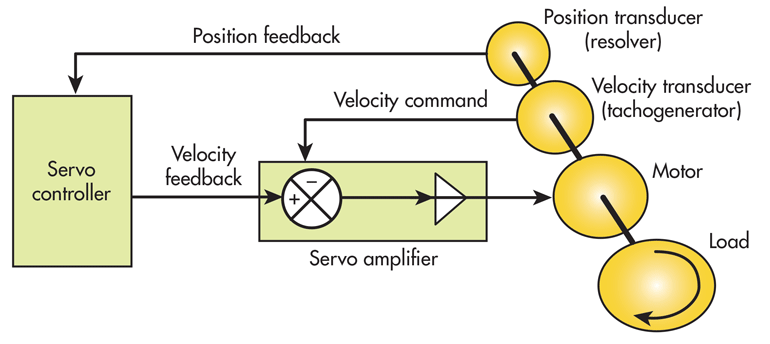A motion control programming system is a straightforward concept: Initiate and control the movement of a load to perform work. They are capable of precise speed, position, and torque control. An application requiring the positioning of a product, synchronization of separate elements, or the rapid start and stop of motion are case examples for the use of motion control.
Such systems are typically comprised of three basic components: the controller, the drive (or the amplifier), and the motor. The controller plans the path or trajectory calculations, sending low-voltage command signals to the drive and applying the necessary voltage and current to the motor, resulting in the desired motion.
The Basics of Motion Control Programming and Robots
The diagram illustrates a typical motion control system, including a servo controller, motors, and transducer.
Programmable logic controllers (PLCs) provide an inexpensive and noise-free method of motion control. Ladder-logic programming has been a staple for PLCs, with newer models featuring human-machine-interface (HMI) panels that are visual representations of the programming code. PLCs can be used to control multiple motion control programming setups and logic control on machinery. In a typical PLC-based motion control system, the high-speed pulse output cards are used in PLCs to generate a pulse train for each servo or stepper drive. The drive receives the pulses, and for each pulse indexes the motor shaft a pre-set amount. A separate signal is used to determine the direction of travel. This method is known as “step and direction.”
Which Factors Are Important?
- Co-velocity: The rate of change of position with respect to time; a vector quantity composed of a magnitude and direction.
- Speed: The magnitude of velocity.
- Acceleration/deceleration: The rate of change in velocity with respect to time.
- Load: The driven elements of the servo system. This includes all of the machine’s components and the work being moved.
- Servo amplifier: Device regulates power to the servo motor.
- Servo controller: Also known as the position controller, the device supplies the programming or instructions to the servo amplifier, usually in the form of analog dc voltage signals.
- Servo motor: Device that moves the load. This is the primary moving element, and it may include a range of prime movers like actuators and induction motors.
- Stepper controller: Device that supplies pulses to excite the windings of a stepper motor and induce mechanical rotation. It is also known as a velocity controller. The frequency or pulses determine the motor velocity and the number of pulses determines the motor position.
- Resolver: A device that monitors the position of the servo motor and the load. Also known as the position transducer.
- Velocity transducer: Also known as the tachogenerator, it monitors the speed of the servo monitor.
What is a Robot?
According to the Robot Institute of America, “a robot is a reprogrammable, multifunctional manipulator designed to move material, parts, tools, or specialized devices through variable programmed motions for the performance of a variety of tasks.” While several of the components found in a motion control system is found inside robots, they are fixed within the robot. The motor speed, actuator, and mechanical links are part of the robot’s makeup. Similarities of Motion Control Systems and Robots
The components that make up a robotic system are similar to those of a motion control system. There is the controller, which allows parts of the robot to operate together and connects it to other systems. The program code is entered into the controller. Also, many modern robots use HMIs built on computer operating systems such as a Windows PC. Robot systems also have drives (i.e., engines or motors) that move links into their designated positions. The links are the sections between the joints. Robots use hydraulic, electric, or pneumatic drives to achieve movement. Sensors are utilized for feedback from the robot’s environments, providing sight and sound used for operation control and safety. They collect information and send it to the robot controller. Differences Between Motion Control Systems and Robots
One major difference between these two systems is time and money. Modern robots are advertised as ready-to-go turnkey solutions. The downside of a robot is the cost. On the other hand, the components that make up a motion control application are modular, and being able to have modular control of a motion system provides greater cost control. However, there is a greater knowledge demand on the user to properly operate the motion control system. Its components will need individual programming from the end user.arm, for example, is already constructed and simple to set up
Please contact our motion control distributors for all of your motion control programming requirements.




